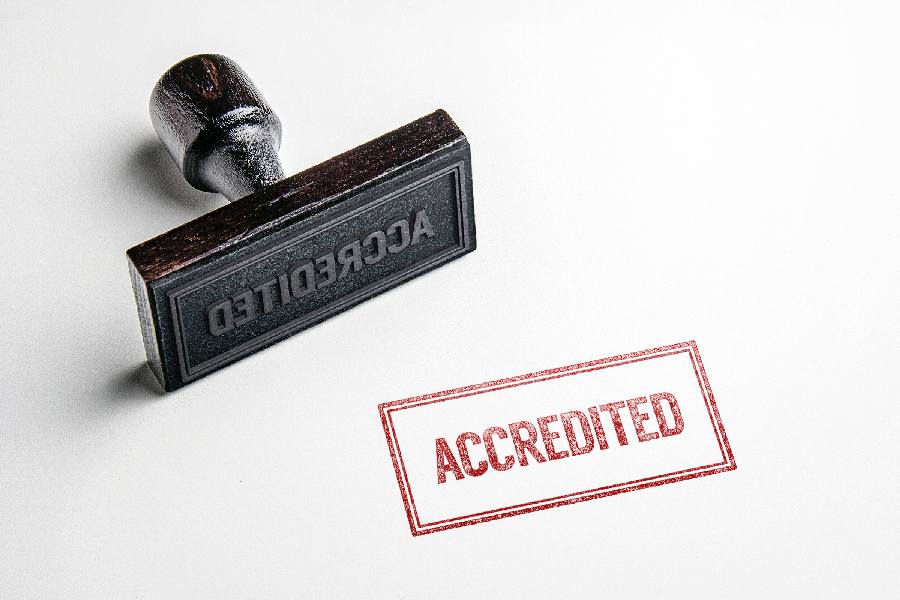How to Get AAAHC Accredited
Achieving accreditation from the AAAHC organization may benefit your healthcare institution. From improving your overall health service quality to filling every gap you’re missing, accreditation can make all the difference. But how to get AAAHC accredited?
Continue reading this article to discover how to get accredited and how you can prepare. Learn more about the process and what you and your organization should expect.
Understanding AAAHC Accreditation
The AAAHC, or Accreditation Association for Ambulatory Health Care, is a private, leading accreditor of ambulatory healthcare organizations in the U.S.
This non-profit organization accredits over 6,000 organizations nationwide and helps them improve their service and medical care for patients.
Many factors separate the AAAHC from other accreditation organizations. One is their peer-based survey process that utilizes practicing healthcare professionals.
Additionally, this organization provides comprehensive education programs and industry-leading research capabilities.
Accreditation by the AAAHC provides insurance for an ambulatory surgery facility that provides the best service and practices in health care while complying with all nationally recognized health and safety standards and requirements.
This accreditation is also recognized by medical societies, health insurance companies, and state and federal government agencies.
Furthermore, the Accreditation Association for Ambulatory Health Care logo is a valuable mark to have on an ambulatory surgery center. The logo represents the facility’s excellent healthcare quality and safety.
Only ASCs certified by AAAHC may display this symbol and showcase their exceptional medical service.

How to Get AAAHC Accredited
Frequently, the Accreditation Association for Ambulatory Health Care is an overlooked step when improving your ASC health care service and reputation.
The accreditation gives your facility and medical team a focus and common purpose to improve and maintain quality medical patient care.
Additionally, it gives an opportunity for the center and team to grow in a professional manner while raising their practice to the next level.
The AAAHC examines and helps to improve areas of the medical facility such as:
- Quality of care
- Use of facilities
- Adherence to best practices
- Management methodology
The efficiency and quality of medical health care services mostly rely on how compliant the health institution is. However, a compliance issue can affect the entire facility’s operation and organization.
Getting accredited by AAAHC will help provide peace of mind knowing that the ASC is protected. This organization complies with the latest regulations and standards in the health industry. However, the AAAHC offers more than just having the proper equipment.
It also involves compliance responsibilities and requirements for care quality and patient safety in the facility. As these procedures may get complicated, ASC Consulting Services may be of great help in achieving AAAHC accreditation.
So, without further stalling, here is how to get AAAHC accredited and how to prepare.
Preparing for AAAHC accreditation
Regarding AAAHC’s approach to accreditation, the surveyors are consultative and educational while presenting best practices to help ASC organizations reach their full healthcare potential.
Ambulatory surgery centers that seek accreditation from the Accreditation Association for Ambulatory Health Care undergo extensive self-assessments and on-site surveys by AAAHC experts.
There are many helpful tips for preparing and assessing readiness for the AAAHC accreditation process. However, you can consider these tips for AAAHC accreditation from experts:
- Stay updated and current, and use handbooks.
- Take mock surveys, and go over emergency and disaster preparedness plans.
- Allow the entire organization and staff to be familiar with the handbooks and standards in order to know what to do to stay prepared.
- Work on developing or improving Quality Improvement studies.
- Keep meticulous documentation and records so you can showcase to surveyors what the ASC is doing.
- Document ongoing surveillance.
- Focus on safe medication purchases and practices, which are especially important to professionals and surveyors during contagious situations.
- Implement patient safety toolkits.
- Participate in ongoing education programs from professional associations.
Self-assessment
First and foremost, healthcare organizations should conduct an internal evaluation and identify any areas that may need improvements. This may include policies, regulations, staff, equipment, safety measurements, etc.
Reviewing the policies, procedures, and compliance with AAAHC standards will help you understand and align their requirements accordingly.
Documentation gathering
Before applying for ambulatory accreditation, an ambulatory surgery center must gather relevant documentation and record-keeping supporting compliance with standards. This can include documentation regarding patient care, safety measurements, medical history, staffing, emergency and disaster planning, and more.
The health facility may include policies, protocols, quality improvement plans, staff credentials, and educational materials.
Benchmarking
When applying for AAAHC accreditation, ambulatory surgery centers typically compare performance and service quality against the industry’s best practices. This will help identify areas for potential enhancement.
Improving the performance with comparison will help meet or exceed AAAHC standards.

Assessing readiness for AAAHC accreditation standards
The AAAHC accreditation standards consist of eight core chapters applicable to all health organizations, including ASC. These chapters range from patient rights to governance, administration, pandemic, infection prevention, and clinical records.
Here are some of each chapter’s highlights so you better understand what the AAAHC is expecting.
Patient rights and responsibilities
One of the first things surveyors check when stepping into a healthcare organization is the written patient rights and responsibilities.
Each ambulatory surgery center and other health facility must have a process by which a patient receives written rights and responsibilities before receiving any services.
This chapter includes the following:
- Policies on cell phones and service animals.
- Multilingual patient information.
- Patient privacy and security policies that comply with the Health Insurance Portability and Accountability Act and Health Information Technology for Economic and Clinical Health Act.
Quality of care provided
The quality of care drives the whole AAAHC organization process of ambulatory accreditation. However, it’s important to remember that this is not specific since they recognize that every healthcare facility differs.
Surveyors examine the ambulatory surgery center and ensure that all medical staff and personnel are accordingly trained and provide the type of care required.
Additionally, an important aspect ambulatory institutions must prepare for is medication reconciliation.
Quality management and improvement
For the AAAHC, every ambulatory surgery center must have an organized, data-driven, and peer-based quality improvement program. This includes:
- Program infrastructure
- Communication of activities
- Ongoing data collection
- Studies
- Benchmarking
Your program infrastructure is going to be defined in your plan. It needs to be precise to your organization. You want to look at what’s important to your organization and health institution and only collect data you care about.
In order to provide a quality improvement study, you have to set a goal and take action to achieve that goal, which must be measurable. The AAAHC application requires the submission of two recently conducted and completed quality improvement studies.
Governance
Every accreditable health organization must have a governing body that sets the policy and regulations and is responsible for the organization.
Issues the governing body is most commonly dealing with are:
- Achieving missions, goals, and objectives.
- Constructing long-range plans.
- Providing adequate and appropriate facilities and personnel.
The governing body is additionally legally responsible for the whole operation and performance of the health institution, including:
- Compliance with AAAHC standards
- Bylaws
- Financial management
- Policies and procedures
- Legal and ethical matters
Every decision, credentialing, and privileging should be documented for surveyors to examine and verify the governing body’s actions.
Administration
A big part of administration comes from the supervision of the ASC and includes:
- Documentation
- Administrative responsibilities
- Patient satisfaction
- Policies and training
Several requirements for orientation and training must be completed in a period of time. Surveyors will look for disaster preparedness, emergency equipment, information technology, and risk management.
Clinical records and health information
An accreditable ambulatory surgery center must maintain electronic or paper clinical records and a medical information system.
AAAHC surveyors examine how clinical record-keeping is executed. Most commonly, they look for documentation of how the ASC is providing care and elements such as organization and consistency. It’s important for the Accreditation Association for Ambulatory Health Care that the health institution cover the important details.
Moreover, AAAHC surveyors examine anything considered an incident or an emergency event by the ASC, how it was handled, and how it was documented.

Infection prevention, control, and safety
According to AAAHC, an ambulatory surgery center must protect patients and medical staff and has a written individual infection control program.
Additionally, the institution must showcase documentation of continued infection prevention and education for the staff.
The program must be naturally recognized by the Association for Professionals in Infection Control and Epidemiology, the Centers for Disease Control and Prevention, or AORN. There may be additional state, federal, and tribal requirements.
An ambulatory surgery center must provide a safe, sanitary, and healthy environment for patients, staff, and visitors. The AAAHC organization ensures minimal risk of spreading infection or disease for patients and staff.
Additional parts of a safety program surveyors expect may include:
- Policy to check for expiration dates on items. This may consist of objects such as medications and sterile supplies.
- Policy for what to do with devices and drugs that are recalled by their manufacturers.
- Policy for disposing of hazardous materials and contaminated items.
AAAHC accreditation process before the survey
The following step-by-step guide is intended to help ASC and health facilities that want to get AAAHC ambulatory accreditation.
Evaluate survey eligibility criteria
In order to be eligible for an accreditation survey by AAAHC, the ambulatory surgery center must meet the following criteria:
- The organization is a formally organized and legally constituted institution primarily providing healthcare services.
- The organization has been offering health services for at least six months before the on-site assessment.
- The organization is in compliance with federal, state, and local laws and regulations.
- The organization is licensed by the state in which it is located.
- The organization provides healthcare services under the direction of a doctor of optometry, chiropractic, dental surgery, medicine, osteopathy, or other.
- The organization operates in alignment with the U.S. Equal Employment Opportunity Commission laws.
- The organization submits a completed, signed survey application, all supporting documents, and an application fee before the survey.
Identify survey type
One of the most vital parts of how to get AAAHC accredited is being familiar with the variety of survey types. If an organization is unsure of the right type of survey, the AAAHC Accreditation Services is at its disposal.
These surveys assist the AAAHC organization in deciding whether an ambulatory surgery center must be accredited.
- Early Option Survey: It is best suitable for organizations that AAAHC does not accredit and meet the criteria. However, these organizations may have been operating for less than six months.
- Initial Accreditation Survey: For organizations with expired AAAHC accreditation. ASC that wants to renew its accreditation may submit all requirements, and the AAAHC will then consider their reapplication.
- Re-accreditation Survey: It is for organizations that are AAAHC accredited but are seeking a continuation of accreditation after they’ve hit the three-year mark.
- Interim surveys: Suitable for organizations with AAAHC accreditation but may still require an assessment to ensure compliance with the accreditation standards.
- Random and Discretionary Survey: This survey is done on accredited organizations. These random surveys are unannounced, and organizations are selected based on a few factors. This includes practice settings, geographic areas, and accreditation decision categories.
Apply for survey
Applying for a survey is an easy, straightforward task. Any ASC that meets the Survey Eligibility Criteria may apply. An ASC organization can either apply for an initial accreditation survey or a continuation of accreditation. This can either be done electronically or in the AAAHC centers.
By submitting the survey, the ASC should:
- Confirm the accuracy and verify the statements in the application and any other information and documentation provided to the AAAHC.
- Agree to follow and comply with the AAAHC organization’s policies and procedures.
- Understand that the AAAHC may use the provided information and collected data throughout the application and survey for quality improvement purposes.

Payment and scheduling
Once the organization has submitted the application, it will receive an automated response. The AAAHC organization will provide the length and cost of the survey once they’ve reviewed the application and its supporting documentation.
The most common key factors determining the fees and lengths of the survey are the type, size, and range of services the organization provides.
Regarding the scheduling, the survey dates are made with cooperation between the AAAHC and the healthcare organization. Every attempt for scheduling is with consideration to be the most convenient time for the requesting institution.
Additionally, the survey must be conducted on a working day when the organization is providing services. Once the dates have been confirmed, the AAAHC informs the organization of the details regarding the survey.
AAAHC accreditation preparation for the survey
The AAAHC emphasizes the educational and beneficial aspects of accreditation even though the survey is evaluative. This organization uses healthcare professionals and administrators to conduct accreditation surveys.
Specific survey team members are selected based on their knowledge and experience with the range of services provided by the organization seeking an accreditation survey, in this case, an ASC.
The Accreditation Association for Ambulatory Health Care awards accreditation to health facilities that demonstrate substantial compliance with the standards and adhere to their accreditation policies.
However, preparation is crucial to ensure a successful accreditation survey. Several key activities and factors take place in the initial phase when preparing for the survey:
- First, a healthcare organization must order a copy of the appropriate AAAHC handbook to review the current and accurate standards for accreditation.
- Next, it’s best to conduct a self-assessment with AAAHC Standards and develop and maintain an action plan to address any gaps, as we’ve mentioned.
- Then an ambulatory surgery center may apply and ready your organization and team for the survey.
- The AAAHC organization determines the length of the onsite visit and examination, the number of surveyors, as well as the survey date and fee.
- The AAAHC organization will inform you of the accreditation decision in the shortest possible time.
During and After the AAAHC Survey
During the survey, the AAAHC specifically determines and tailors each survey by the type, size, and various ranges of services provided by the ambulatory surgery center seeking accreditation.
The length of the survey and the number of surveyors sent is entirely based on careful review and consideration of the information and data provided in the application.
The supporting documents sent with the application by the ASC seeking accreditation are also key factors for the survey decision.
The following is the full process of a survey conducted by the AAAHC:
Survey team
To begin the survey, professionals and administrators who are actively involved in ambulatory health care settings visit and examine the ASC. This may include registered nurses, ambulatory health care facility administrators, dentists, and other professionals in the field.
These individuals take the time and effort to train and work as surveyors to help in the consistent application of the standards with their practical knowledge.
The AAAHC may determine additions to the survey team, and this may include:
- Observers: They are Accreditation Association for Ambulatory Health Care-approved additions that observe and may improve the accreditation quality. However, these observers do not participate in the on-site survey in any manner and do not result in additional charges to the health organization.
- Additional surveyors: The AAAHC has the right to assign additional surveyors on an ongoing survey process. These individuals may actively participate in an on-site procedure.
AAAHC surveyor policy and practices
As a surveyor of the AAAHC, their priority should be objective fact findings and education when appropriate. There are a few regulations of the AAAHC policy and practices that must be followed:
- The surveyors assigned must not be in direct competition with their business interests.
- The surveyors assigned or must not bear any significant beneficial interest to themselves or their immediate family.
- The surveyors assigned may not solicit personal business.
The on-site process
At the start of the survey, surveyors conduct an orientation conference for the health organization. At this conference, all the necessary documentation, information, survey format, personnel identification, and additional documents that surveyors may require.
The ASC must provide a private or semi-private area in the facility that surveyors may use. This area will be available for conducting interviews, reviewing documentation, and holding survey team meetings.
Furthermore, surveyors must attend and observe surgeries, service quality, equipment, performance, and procedures the ambulatory surgery center provides. If the organization cannot provide an observation site for surveyors, it may cause a ground for termination of the accreditation process.
Toward the end, surveyors conclude the survey experience and conduct a conference stating their findings. This is the time when members of the organization have the opportunity to comment on the finding and express their perceptions.
Accreditation decision and notification
The AAAHC organization makes accreditation decisions after reviewing the collected data from the survey and applicable supporting documentation. The organization expects substantial compliance with its standards.
Compliance is assessed through at least one of the following:
- Evident documentation
- Responses to detailed questions regarding implementation
- On-site observations and interviews
Accreditation will be awarded if the health institution complies with the standards and accreditation policies.
In addition, if consideration for denial occurs, the ASC has an opportunity to provide additional information before finalization.
On the other hand, if a decision is made to revoke accreditation, the organization will be notified as soon as possible. In the notice, there will be the effective date of the revocation for the ASC.
Following a survey, an ambulatory surgery center may either be awarded three-year term accreditation or denied accreditation. This concludes that an organization complies with the standards and is committed to providing high-quality care and service.

Conclusion
Knowing how to get AAAHC accredited and how to prepare may make all the difference. Accreditation is a public symbol that showcases an ASC’s commitment to providing high-quality health and service to their patients.
Additionally, this allows organizations to learn and grow on a professional level and provide their full potential.
Hopefully, this article has provided useful information about getting AAAHC accreditation.





